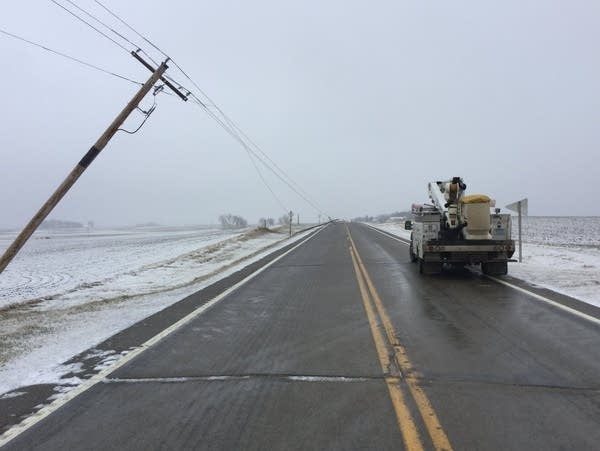Winter storm left costly damage in southern Minnesota

Go Deeper.
Create an account or log in to save stories.
Like this?
Thanks for liking this story! We have added it to a list of your favorite stories.
Mower County Sheriff Steve Sandvik describes the aftermath of last Thursday's storm in a single word: apocalyptic.
After freezing rain coated trees and power lines with ice, 50-mph winds began toppling them over.
"When it was all said and done, many of the areas of our county looked like a war zone, with trees down, large power poles down in huge groups," Sandvik said. It was almost unbelievable that no one was injured or killed, he said.
The electricity is back on for nearly all of the thousands of Minnesotans who lost power after last week's late winter storm. Now, work is beginning to tally up the costs of the blizzard that pummeled much of the state with ice, snow and wind.
Turn Up Your Support
MPR News helps you turn down the noise and build shared understanding. Turn up your support for this public resource and keep trusted journalism accessible to all.
In all, about 2,000 utility poles across southern Minnesota were damaged, leaving more than 15,000 homes and businesses without power.
Freeborn-Mower Cooperative Services had about 750 broken or downed utility poles, said spokesperson Mary Nelson. It requested help from other cooperatives, who sent about 150 extra linemen to repair damaged poles. They worked 16- or 17-hour days from Thursday through Tuesday, Nelson said.
Those recovery efforts are helping communities return to normal. But Nelson said they're also expensive.
"I would not even be able to guess at the large number of the cost [of] this storm, but it would be in excess of millions," she said.
Gov. Tim Walz surveyed the storm damage last weekend and has said he plans to ask the federal government for disaster relief assistance.
In a letter Monday to the White House, the governor said this spring's weather has been "very challenging," with historic snowfalls and spring floods.
Joe Kelly, state director of Homeland Security and Emergency Management, said it will take a couple of weeks for utility companies and local governments to add up their expenses, including equipment and overtime pay.
He said it's still early, but it's "pretty clear" that the total damages will exceed the $8 million threshold to qualify for federal disaster assistance.



